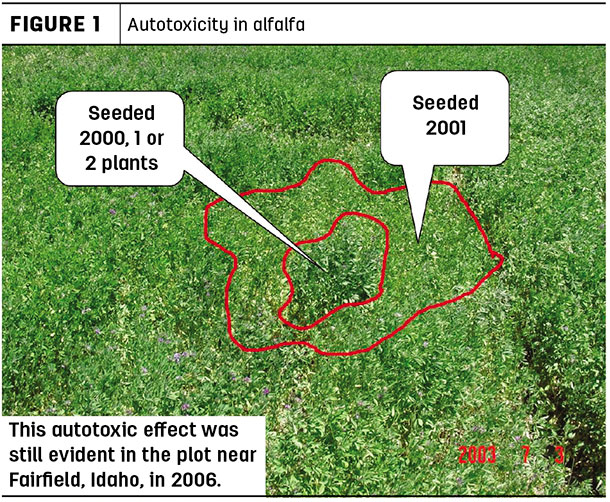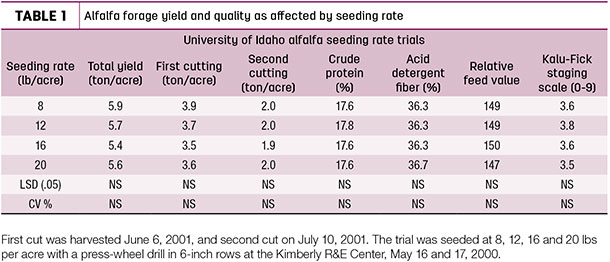Key points to get good stands are presented in the following sections.
Plan for a stand
Rotation – Alfalfa stands should be rotated with at least one year between stands to avoid autotoxicity (Figure 1).

Alfalfa produces toxins that reduce germination and growth of new alfalfa. Several years are better to reduce pests and diseases and to take advantage of the nitrogen credits from mineralized nitrogen from decaying alfalfa roots.
Control weeds that will be a problem during stand establishment of alfalfa in the interim of rotations. Beware of applying long-acting herbicides that may affect alfalfa establishment. Soil test and apply nutrients with manure, compost and commercial fertilizer to be within the sufficient nutrient zones, especially for low mobility nutrients such as phosphate.
Variety – Choose a variety that is well-suited to your environment, has appropriate resistance to diseases and insect pests for your area, and has good yield. Look for varieties that have proven yield results from several tests by independent university trials.
Buy from a reputable dealer that also provides agronomic advice. I firmly believe there is no such thing as “cheap” seed, so invest in a high-quality seed. Make sure you read the seed tags to ensure the seed was represented accurately and meets certification standards.
Timing – Seed at the proper time for your environment. Late summer seedings will provide for better first-season yields than spring plantings. Late-summer-planted alfalfa will compete better against spring annual weeds such as lamb’s-quarters and red root pigweed.
Sowing
Prepare a firm seedbed. Test the firmness by walking over the area and observing the depth your shoe sole sinks in. The two most common reasons for stand failure are a loose seedbed and improper seeding depth, and these are closely related. A few clods or crop residue is not a problem as long as the seedbed is firm and there is good seed-to-soil contact.
A soft seedbed is not conducive to having adequate water in close contact with the seed, so germination is delayed or fails. The quicker the seed can imbibe water, germinate and emerge, the less opportunity pests and diseases have to reduce seedling vigor.
Use an appropriate seeding rate. Sow at the recommended rate for your equipment and environment. The preferred equipment is 1) a press-wheel drill with depth adjustment or 2) a combination roller seeder-roller (i.e., Brillion planter). Both have depth control and firm the seedbed after seed placement.
Repeated university tests show that 12 to 16 pounds per acre of pure live seed is more than enough to get a good stand. Broadcast sowing requires more seed, although I still don’t recommend more than 20 pounds per acre. I have witnessed very poor stands even at high seeding rates when sown with air-distributed fertilizer spreaders and rolling it in.
Sowing 30 pounds per acre is just wasting seed in my opinion and reveals salesmen are only interested in commissions. The university trials seldom show a yield, weed control, forage quality or stand persistence response to seeding rates over 10 pounds per acre. Table 1 shows data from Kimberly, Idaho, where there was no significant yield effect due to seeding rate.

With good management and cooperative weather, the initial stand should be 25 to 30 plants per square foot. Stands are reduced to about 12 plants per square foot after the first year with almost all seeding rate studies.
Seed coating: the good, the bad, and the ugly. Depending on the coating, it can be all, partial or none. Gypsum and lime coatings can buffer soil pH near the seed piece. Gypsum, lime, clay and polymer coatings help to attract water next to the seed, allow for more and better protected inoculants and fungicide treatment, and may extend limited seed because of better seedling establishment.
Gypsum-based coatings with added micronutrients may benefit seedling development and rhizobia inoculation in soils with very low pH.
The disadvantages of seed coatings are the higher cost per pound of pure live seed and the issues of moisture attraction in the seed box when high humidity or rain occurs. Be aware that a 31 percent seed coating results in 31 percent less seeds in a bag, so price of seed should be determined on a cost per pound of pure live seed.
I have seen in producer fields and demonstrated in trials that seed coatings sometimes increase vigor and stand counts, and sometimes first-cutting yield, but then the differences disappear.
Nurse or competition crop? Companion crops may be prescribed if your soil is prone to wind or water erosion. A companion crop may also help with weed control in organic operations. The earlier a companion crop is eliminated or harvested, the better the alfalfa stand the first year and thereafter. Use a light rate of cereal grain, such as 10 to 30 pounds per acre of oats.
Several herbicides are suitable for terminating a cereal nurse crop after a stubble is formed to reduce erosion. All plants growing with alfalfa are in competition for resources: water, nutrients and light. So nonalfalfa plants will reduce the vigor of alfalfa seedlings and may cause more of them to fail establishment.
Seedling management. Scout for soil crusting, weed and insect infestations, and moisture in new seedings. Weeds must be controlled by clipping or herbicides applied at the proper stage of alfalfa and weed development.
Profitability depends on a good stand
A good stand of alfalfa will produce good yields and minimize weed problems for the life of the stand. Don’t skimp on buying the best seed, nutrients or pesticides required for your situation. ![]()
PHOTO: Alfalfa establishment – good or poor – determines yield and quality in subsequent years. Steps are outlined to ensure a vigorous and successful stand. Photo by Mike Dixon.

-
Glenn Shewmaker
- Forage Extension Specialist
- University of Idaho
- Email Glenn Shewmaker











